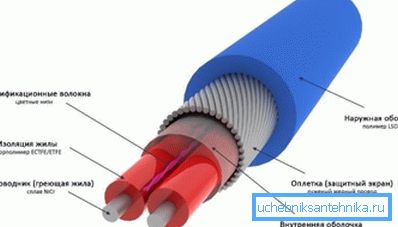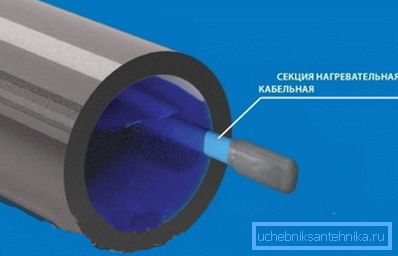What is the heating cable for plumbing
In any climate zone, freezing of water in pipelines during the cold period is a big problem. This also includes the freezing of sewage pipes and roofs in the winter. The key element of heating in this case is the heating cable used in industry and in everyday life to solve such difficulties. The product is a conductor with high resistance, in which the temperature rises when electric current passes through it.

What it consists of
This type of cable product does not play the role of a transmission line, but is a receiver of electricity. Its principle of operation is to convert it into heat, which occurs without the use of additional fuel, i.e. economical method. The main parameter is power or specific heat release per unit length.

The design consists of:
| Internal vein (lived) | The main structural element, which can be steel, copper, nichrome or a special alloy with high electrical resistance. |
| Protective shell | Polyvinyl chloride with aluminum screen or copper shielding mesh. |
Tip: choosing a heating cable, although the price of single-core version is low, it should be noted that it has a significant drawback - electromagnetic radiation. In multicore products it is not.
Classification
In this case, the designs differ according to the heat release scheme.
Resistive
- Can be zoned and linear. In the latter, heat is released due to the Joule-Lenz effect.
- This type of cable can be with one conductor, with two or with several conductors of linear or spiral form.
- Sections can reach several hundred meters.
- The instruction does not allow arbitrary cutting.
- Zonal cables or constant power have the same principle of operation, but, their design is different.

- The products consist of two isolated parallel conductive wires with “windows” in isolation, which are displaced relative to each other by a certain distance.
- A thin high resistance wire spiral is placed on top of the cores.
- In fact, the zone cable consists of sections, which allows it to be divided into them.
Self-regulating
- The design of the device is similar with resistive models.
- There are two parallel conductors, however, without an insulating coating. They are enclosed in a polymeric conductive matrix or are connected by polymeric conductive filaments.
- Heat dissipation of the cable may vary, as it depends on the temperature of its environment.
- The resistance of the polymer increases even with a slight increase, while the heat release decreases.
- This effect allows self-regulation, preventing the device from overheating and burning.
- Such a heating cable can be cut into pieces of several tens of meters in length.

Mineral Insulated
This type of cable has a conductor represented by a conductive core of copper or alloys of various resistances. The insulator is magnesium oxide, which has valuable physical properties that are designed to ensure stable operation and high dielectric qualities of equipment in a wide temperature range.
Product Benefits:
- high mechanical characteristics;
- tightness;
- resistance in various environments;
- does not respond to UV radiation;
- small linear expansion coefficient;
- maximum protection against electromagnetic radiation;
- high linear power;
- long service life.

How is the heating of the pipeline
Heating cables of various types are widely used in everyday life and industry. It happens that they are used for heating the floor, tanks and tanks, used to maintain the desired floor temperature in the freezer. However, most often they can be found when heating water pipes, when using this product it is possible to prevent freezing of water and the formation of ice on the surface.
The installation of this heating system is usually carried out on the surface of pipes under thermal insulation. There are also options for placing a self-regulating heating cable inside the water supply if it is allowed by the norms of the product to come into contact with drinking water.
Tip: during installation, make sure that the heating cable does not touch the thermal insulation with aluminum foil.
Installation rules and features:
- The heating system of the pipeline consists of:
- heating cable;
- control systems;
- distribution network.
- Most often it is placed on the surface of the pipeline and covered with insulating material.

- The cable is laid in a spiral, parallel and wavy lines.
- Fix it with a special adhesive tape, better than aluminum.
- Aluminum tape is used as a gasket between the cable and the plastic piping, allowing heat to spread evenly.
- Installation can be done by hand, given the manufacturer's recommendations.
Conclusion
At the onset of the cold period there is a real danger of freezing of the aqueduct, especially when, for certain reasons, it is not laid deep enough in the ground. To solve this problem, you can use a heating cable that runs on electricity.
It is of different types, so when choosing, you should first carefully review the characteristics of the product. The video in this article will provide an opportunity to find additional information on the above topic.